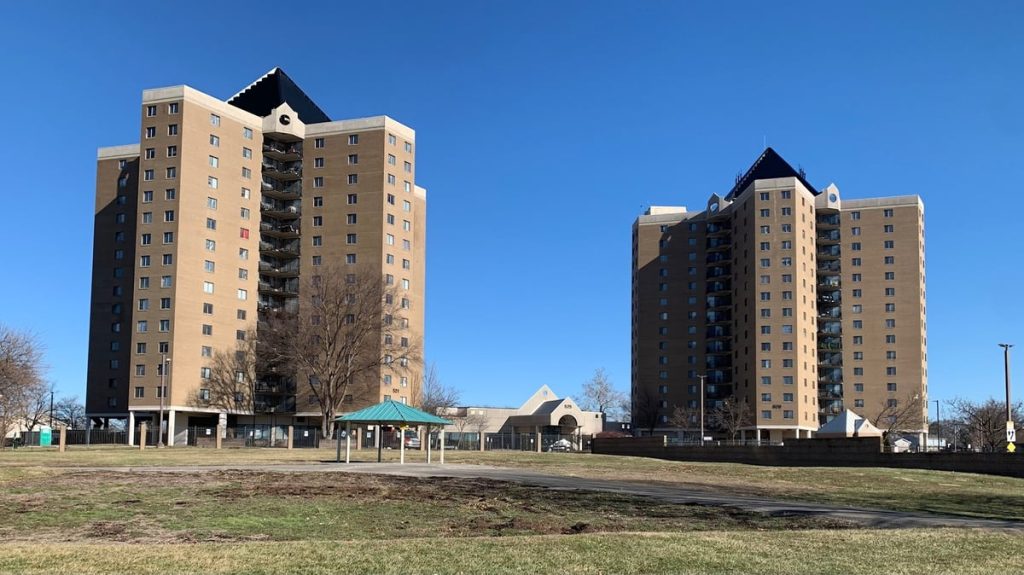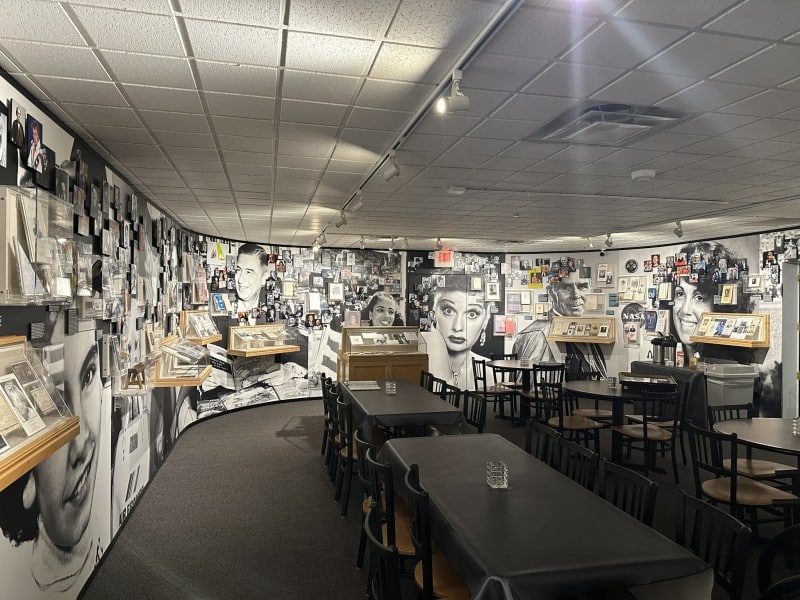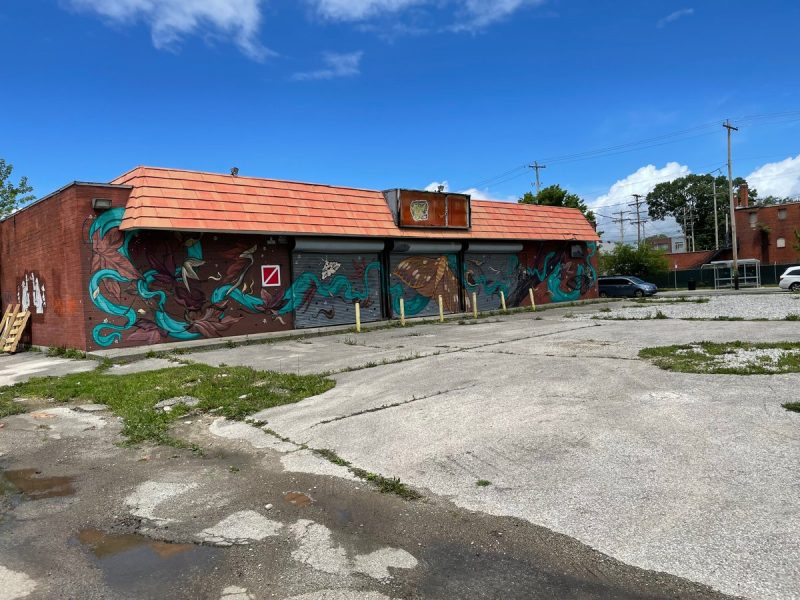
In late January, nearly six weeks after Charles Brooks joined his fellow tenants in the Christmas Day evacuation of the Latitude Five25 apartment towers on the Near East Side, he was still adjusting to life in temporary housing – a small room at the Sonesta Simply Suites in Gahanna, adjacent to the John Glenn Columbus International Airport.
“I apologize for the mess,” Brooks said as he ushered me into the space, which was outfitted with a queen bed, a nightstand with a lamp, a small desk and chair, and a flat-screen television tuned to the news, its volume muted. Off to the side, there was also a small kitchenette equipped with a refrigerator, a stovetop and a microwave, though Brooks said he had done little cooking since moving into the space a couple of weeks earlier.
It was late afternoon, and Brooks had recently returned to the motel from his day job as a temporary worker at a warehouse in Grove City, a commute that Brooks said can take north of 40 minutes in traffic, and which required him to leave for work on most days by 5:30 a.m. – nearly half hour earlier than he did while living at Latitude.
Beyond the cramped accommodations and the longer commute, Brooks said life at the motel could also be more isolating. “Living at the tower, it was more of a community, and some of the older people who couldn’t make it to the store, maybe you run errands for them, or walk to the store for them,” said Brooks, who has alternated between reading his bible and binge-watching TV while living at the motel. “In a building that large, you don’t know everybody, but you get to know some of them, and there were a lot of good people in there. … So, it definitely does get lonely, and there’s definitely a little depression. I’m a private person, so it was strange that when you reached out to me that I reached back out to you, but I know sometimes holding things in isn’t good. Maybe I talk to you, I talk to someone else, and it calms me.”
Initially, Brooks said he believed he would be in the Sonesta through February, at the longest, his accommodations provided by Franklin County in partnership with the Community Shelter Board, Impact Community Action and the city of Columbus. But with less than a third of the 154 households displaced by the closure of Latitude having found permanent shelter, Brooks said he’d heard plans were already in motion to extend these temporary stays through March, if needed. “Maybe it happens,” Brooks said. “I’m going to start pushing the issue on it in February, because it’s a short month and I don’t want to be out here naked, wondering, ‘What am I going to do next?’’
The question is one nagging former residents of the problem-plagued apartment towers, the sudden closure of which has increased the strain on an already overtaxed affordable housing market. “This is why you see local leaders talk about the need to preserve affordable housing,” said Graham Bowman, a lawyer for the Legal Aid Society of Columbus, which is representing more than 50 displaced residents of Latitude. “You have this aging stock, where some of these properties were built decades ago. And as they get to the end of their lives, we need to make sure units are being built. It’s an all-hands-on-deck conversation that needs to take place.”
First dubbed Bolivar Arms, the 400-unit twin towers were designed by Schooley, Cornelius & Schooley and built in 1963 on a large tract of land just south of Interstate 670 on Sawyer Blvd. A May 1966 report on the Columbus housing market prepared by the Federal Housing Administration stated that the complex provided “much needed units for larger families.”
Following a $2.5 million remodeling, the apartment buildings, operated by the Columbus Metropolitan Housing Authority (CMHA), were rededicated as Sawyer Towers in August 1970. The twin-high rises remained under CMHA control through 2010, when, crime-ridden and facing demolition, the complex was purchased by VTT Management Inc., which renovated the buildings and renamed them Skyview Towers. In 2016, VTT sold the complex to New York-based Asia Capital Real Estate Associates, the property changing hands once more when it was purchased by Paxe Latitude LP in 2021.
From construction, the towers generated complaints from tenants. In a 1966 master’s thesis, one Ohio State student surveyed the people living at Bolivar Arms, who shared their displeasure with everything from the compact living conditions to the lack of recreational facilities available to children and adults at the property.
Brooks moved into Latitude two-and-a-half years ago, at a time when conditions at the property had already declined precipitously. He said he experienced constant issues with heat and air conditioning, and that it wasn’t unusual for the hot water to go out for days at a time. There were also recurring mechanical issues with the elevators in both buildings. “You’d hear stories about people being trapped, having to go down flights of stairs for doctor’s appointments,” said Brooks, who paid $925 a month for his fifth-floor apartment at Latitude. “So, I wanted to get out of that building. Just not like this.”
Bowman said many of the tenants he represents from Latitude shared a similar experience – desiring to leave behind the complex and its infestations, power and water outages, and unsanitary conditions – but also not having anywhere else to go owing to the dearth of affordable housing options in the city. “And that gives acting landlords a lot of leeway,” Bowman said, “because tenants don’t have the option to vote with their feet.”
Similarly, Bowman said the Columbus City Attorney’s Zone Initiative Team is equipped with the strong tools needed to hold landlords accountable, but that overly strict enforcement could also accelerate the growing housing crisis. “[The Zone Initiative] can’t create good-acting landlords, and it can’t create alternative housing for people,” Bowman said. “It creates a difficult situation, because the enforcement mechanism for a really bad property like [Latitude] is to shut it down, which would result in people losing their homes. … And that’s the challenge of the landscape that we’re dealing with here.”
The most recent problems at Latitude started on Dec. 23, when a sprinkler head broke in subzero temperatures after someone left a sliding door open. This caused a chain reaction in the outdated plumbing system, with myriad line breaks leading to extensive flooding and the Christmas Day evacuation of the buildings.
In the immediate aftermath, some residents like Charles Brooks were able to stay temporarily with friends or family elsewhere in the city. “We just packed up suitcases like we were going to the airport,” Brooks said. Others were taken by bus to Dodge Community Center in Franklinton, where the American Red Cross established an emergency shelter at the request of the Columbus Fire Department. “When we activated, we had the shelter up and running in a couple hours,” said Atticus Garden, disaster program manager for the Greater Columbus chapter of the American Red Cross. “Obviously, there’s never a good day to open a shelter, but it’s certainly harder on Christmas.”
According to Garden, 34 people were housed at Dodge at peak occupancy, a majority of whom were older and single.
“Getting that call on Christmas Day, when we’d just had a pageant where kids reenacted that Mary and Joseph didn’t have a place to rest their heads, makes it pretty easy to go, ‘What’s the Christian response here?’” said Jed Dearing, associate rector at Trinity Episcopal Church, who arrived at Dodge on Christmas to provide counseling and a willing ear to anyone who needed one. “There was one woman who had just put her deposit down and paid her first month’s rent. And she moved in on Christmas Eve, and had to be evacuated out the next day. And she was two months pregnant. So, just to sit there with all of those stories, and the ways folks had ended up [at Latitude], and then ended up out in the cold.”
Generally, though, Dearing and others said the mood was, if not light, at least accepting of the situation, with many believing they’d be able to return to the towers in short order. Pizza arrived courtesy Cottage Inn, and the Latitude residents and aid workers shared a group dinner. Spirits were high. “People were almost joking, like, ‘Well, at least it’s warmer here than in our apartments, so we have that going for us,’” Dearing said.
Bowman ascribed this response in part to a “general desensitization” that has settled in among some of the longer-term Latitude residents, many of whom had grown accustomed to water pipes breaking and the power going out. The scale of this disaster, however, proved to be magnitudes worse, and when news broke at Dodge the next day that residents would not be able to return immediately to Latitude, if at all, the mood soured.
“It was tough watching that wash over people’s faces: ‘Wait, we can’t go back?’; ‘So we don’t have homes?’; ‘What about my things?’” Dearing said.
Garden broke the news to those at Dodge as part of the Red Cross’ daily information-sharing meeting the day after Christmas, having discussed the still-fluid situation in an early afternoon phone call with stakeholders both public and private. (On the call, Garden said a short-term plan was put in place, with the Community Shelter Board taking lead on the casework, with initial intake and risk assessments set to begin the next morning.)
“It’s not good news to share, and it’s certainly worse news to receive,” Garden said. “But the reality is most of these people just wanted the truth. … At one point, one woman, she was the last question, and she raised her hand and she said, ‘Just to be clear, we’re homeless now?’ And that’s a really hard question to field. … But the reality was, at least in the short-term, that was the case, since people were not going to be returning to their apartments.”
Even prior to the Christmas closure, the future of Latitude had been in flux. In September, the Columbus city attorney’s office sought a contempt order against Paxe Latitude LP for failing to address a host of safety issues. And in November, Paxe Latitude reached a deal with the city to sell the complex. Once a new owner is in place, Bowman said, virtually any outcome is possible.
“You could have an owner determine the buildings just aren’t salvageable and need to be demolished, and that land would be redeveloped as something else,” Bowman said. “I would love to see it remain as affordable housing, because those towers are an integral part of our affordable housing infrastructure in the city, and it houses a lot of people who have nowhere else to go. If you look at the affordable housing crisis in Columbus, and then you subtract 400 units, it’s going to be even worse, and you’re going to see an increase in homelessness.”
At the same time, Bowman has clients who would never return to the towers, even if they were rehabbed and reopened – likely an expensive proposition. Brooks, for one, said he hopes he can find something along the lines of a townhouse, maybe on the western outskirts of Franklinton. Something with a couple of bedrooms, one-and-a-half bathrooms and an unfinished basement. Maybe even a small yard, if he’s fortunate.
“I really have no expectations of ever going back [to the towers],” Brooks said. “One nightmare is enough.”



